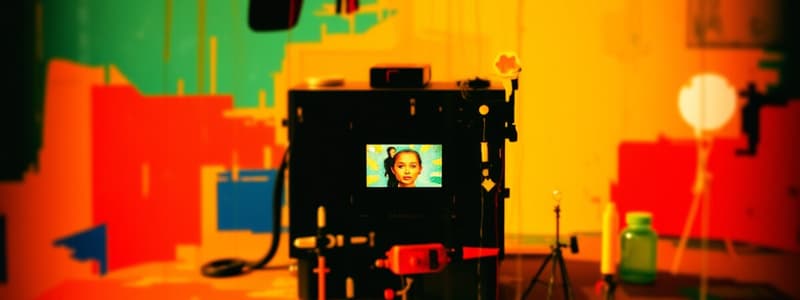Podcast
Questions and Answers
What inspired Edwin Land to develop the first instant camera?
What inspired Edwin Land to develop the first instant camera?
- The need for faster photo development
- A request from his daughter (correct)
- His fascination with photography
- A desire to innovate color photography
In what year did Polaroid launch the Land Camera model 95?
In what year did Polaroid launch the Land Camera model 95?
- 1950
- 1945
- 1948 (correct)
- 1955
What is the subtractive color method used in Kodak's Kodachrome films?
What is the subtractive color method used in Kodak's Kodachrome films?
- Combining primary colors to create white
- Starting with black and adding colors
- Absorbing wavelengths to create color perception (correct)
- Using digital pixels to create color images
What significant change did the digital revolution bring to photography in 1984?
What significant change did the digital revolution bring to photography in 1984?
What was the main purpose of Kodak's first professional digital camera released in 1991?
What was the main purpose of Kodak's first professional digital camera released in 1991?
What was a major advantage of digital photography over traditional film photography in the late 20th century?
What was a major advantage of digital photography over traditional film photography in the late 20th century?
Why was Kodachrome film significant in commercial photography?
Why was Kodachrome film significant in commercial photography?
What technological advancement began in 1984 that significantly influenced photography?
What technological advancement began in 1984 that significantly influenced photography?
What was the primary motivation behind George Eastman's introduction of the Kodak box camera?
What was the primary motivation behind George Eastman's introduction of the Kodak box camera?
What was the price and photo capacity of the Kodak camera introduced by Eastman in 1888?
What was the price and photo capacity of the Kodak camera introduced by Eastman in 1888?
Which camera introduced by Eastman Kodak aimed specifically at children?
Which camera introduced by Eastman Kodak aimed specifically at children?
What significant development in film occurred in the 1930s?
What significant development in film occurred in the 1930s?
What was a major drawback of the 35mm film used in the Leica cameras initially?
What was a major drawback of the 35mm film used in the Leica cameras initially?
Which feature of the Brownie Camera contributed to its popularity?
Which feature of the Brownie Camera contributed to its popularity?
Who assisted George Eastman in the invention of paper film?
Who assisted George Eastman in the invention of paper film?
Why did some professional photographers prefer the dry plate method over Eastman's innovations?
Why did some professional photographers prefer the dry plate method over Eastman's innovations?
What was the main limitation of the camera obscura compared to modern cameras?
What was the main limitation of the camera obscura compared to modern cameras?
Which process introduced the first actual photography negative?
Which process introduced the first actual photography negative?
Who is credited with the development of the daguerreotype method in France?
Who is credited with the development of the daguerreotype method in France?
What substance did Joseph Nicéphore Niépce initially use to capture his first permanent image?
What substance did Joseph Nicéphore Niépce initially use to capture his first permanent image?
Which photographic process was dominant from 1851 to 1880 for making photographs?
Which photographic process was dominant from 1851 to 1880 for making photographs?
Which feature was an improvement of the wet plate collodion process over earlier methods?
Which feature was an improvement of the wet plate collodion process over earlier methods?
What was significant about William Henry Fox Talbot's work with the calotype process?
What was significant about William Henry Fox Talbot's work with the calotype process?
What material was used in the wet plate collodion process to capture detailed images?
What material was used in the wet plate collodion process to capture detailed images?
Flashcards are hidden until you start studying
Study Notes
Evolution of Photography
Early Concepts
- Camera Obscura concept dates back to 400 B.C., attributed to philosophers Mozi and Aristotle.
- Projects images through a pinhole or lens onto a surface; does not capture images.
- Pinhole cameras, emerging in the 1500s, share similarities with camera obscuras but lack lenses.
19th Century Innovations
- 1826: Joseph Nicéphore Niépce creates the first permanent photograph using heliography and silver chloride.
- 1839: Louis Daguerre announces the Daguerreotype process using silver plates for image development.
- 1841: William Henry Fox Talbot introduces the Calotype process utilizing paper coated with silver iodide, creating the first photograph negatives.
- 1851: Frederick Scott Archer develops the Wet Plate Collodion process, allowing for sharper images and reproducibility; dominant from 1851-1880.
- 1888: George Eastman launches the Kodak camera, making photography accessible to the public with the slogan “You press the button, we do the rest.”
20th Century Developments
- 1900: Kodak introduces the Brownie camera, priced at $1, aimed at children, achieving massive popularity.
- 1930s: 35mm film gains traction, especially with Leica cameras designed by Oscar Barnck; improved version released in 1925.
- 1948: Edwin Land develops the first Polaroid instant camera, allowing immediate photo development; launched at $89.75.
- 1950: Kodak's Kodachrome film makes color photography commercially viable, known for its vivid colors.
- 1984: Digital revolution begins with prototypes for digital cameras, enabling photo storage and editing on computers.
Digital Age
- 1991: Kodak releases the first commercial digital camera aimed at press photographers equipped with a 1.3-megapixel sensor, altering the landscape of news photography.
Studying That Suits You
Use AI to generate personalized quizzes and flashcards to suit your learning preferences.





